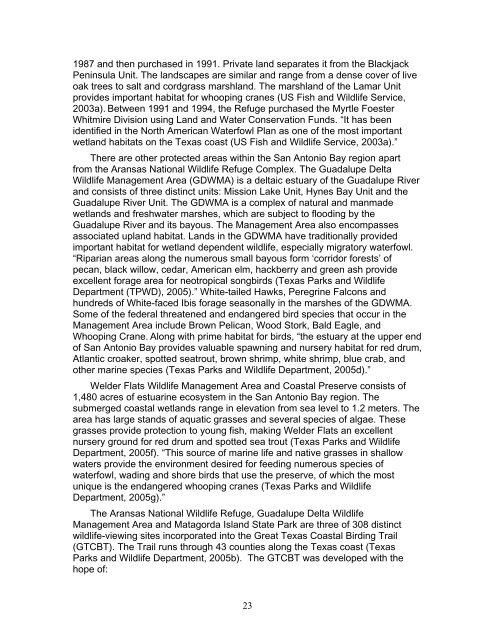The Economic Value of Water and Ecosystem Preservation
The Economic Value of Water and Ecosystem Preservation
The Economic Value of Water and Ecosystem Preservation
Create successful ePaper yourself
Turn your PDF publications into a flip-book with our unique Google optimized e-Paper software.
1987 <strong>and</strong> then purchased in 1991. Private l<strong>and</strong> separates it from the Blackjack<br />
Peninsula Unit. <strong>The</strong> l<strong>and</strong>scapes are similar <strong>and</strong> range from a dense cover <strong>of</strong> live<br />
oak trees to salt <strong>and</strong> cordgrass marshl<strong>and</strong>. <strong>The</strong> marshl<strong>and</strong> <strong>of</strong> the Lamar Unit<br />
provides important habitat for whooping cranes (US Fish <strong>and</strong> Wildlife Service,<br />
2003a). Between 1991 <strong>and</strong> 1994, the Refuge purchased the Myrtle Foester<br />
Whitmire Division using L<strong>and</strong> <strong>and</strong> <strong>Water</strong> Conservation Funds. “It has been<br />
identified in the North American <strong>Water</strong>fowl Plan as one <strong>of</strong> the most important<br />
wetl<strong>and</strong> habitats on the Texas coast (US Fish <strong>and</strong> Wildlife Service, 2003a).”<br />
<strong>The</strong>re are other protected areas within the San Antonio Bay region apart<br />
from the Aransas National Wildlife Refuge Complex. <strong>The</strong> Guadalupe Delta<br />
Wildlife Management Area (GDWMA) is a deltaic estuary <strong>of</strong> the Guadalupe River<br />
<strong>and</strong> consists <strong>of</strong> three distinct units: Mission Lake Unit, Hynes Bay Unit <strong>and</strong> the<br />
Guadalupe River Unit. <strong>The</strong> GDWMA is a complex <strong>of</strong> natural <strong>and</strong> manmade<br />
wetl<strong>and</strong>s <strong>and</strong> freshwater marshes, which are subject to flooding by the<br />
Guadalupe River <strong>and</strong> its bayous. <strong>The</strong> Management Area also encompasses<br />
associated upl<strong>and</strong> habitat. L<strong>and</strong>s in the GDWMA have traditionally provided<br />
important habitat for wetl<strong>and</strong> dependent wildlife, especially migratory waterfowl.<br />
“Riparian areas along the numerous small bayous form ‘corridor forests’ <strong>of</strong><br />
pecan, black willow, cedar, American elm, hackberry <strong>and</strong> green ash provide<br />
excellent forage area for neotropical songbirds (Texas Parks <strong>and</strong> Wildlife<br />
Department (TPWD), 2005).” White-tailed Hawks, Peregrine Falcons <strong>and</strong><br />
hundreds <strong>of</strong> White-faced Ibis forage seasonally in the marshes <strong>of</strong> the GDWMA.<br />
Some <strong>of</strong> the federal threatened <strong>and</strong> endangered bird species that occur in the<br />
Management Area include Brown Pelican, Wood Stork, Bald Eagle, <strong>and</strong><br />
Whooping Crane. Along with prime habitat for birds, “the estuary at the upper end<br />
<strong>of</strong> San Antonio Bay provides valuable spawning <strong>and</strong> nursery habitat for red drum,<br />
Atlantic croaker, spotted seatrout, brown shrimp, white shrimp, blue crab, <strong>and</strong><br />
other marine species (Texas Parks <strong>and</strong> Wildlife Department, 2005d).”<br />
Welder Flats Wildlife Management Area <strong>and</strong> Coastal Preserve consists <strong>of</strong><br />
1,480 acres <strong>of</strong> estuarine ecosystem in the San Antonio Bay region. <strong>The</strong><br />
submerged coastal wetl<strong>and</strong>s range in elevation from sea level to 1.2 meters. <strong>The</strong><br />
area has large st<strong>and</strong>s <strong>of</strong> aquatic grasses <strong>and</strong> several species <strong>of</strong> algae. <strong>The</strong>se<br />
grasses provide protection to young fish, making Welder Flats an excellent<br />
nursery ground for red drum <strong>and</strong> spotted sea trout (Texas Parks <strong>and</strong> Wildlife<br />
Department, 2005f). “This source <strong>of</strong> marine life <strong>and</strong> native grasses in shallow<br />
waters provide the environment desired for feeding numerous species <strong>of</strong><br />
waterfowl, wading <strong>and</strong> shore birds that use the preserve, <strong>of</strong> which the most<br />
unique is the endangered whooping cranes (Texas Parks <strong>and</strong> Wildlife<br />
Department, 2005g).”<br />
<strong>The</strong> Aransas National Wildlife Refuge, Guadalupe Delta Wildlife<br />
Management Area <strong>and</strong> Matagorda Isl<strong>and</strong> State Park are three <strong>of</strong> 308 distinct<br />
wildlife-viewing sites incorporated into the Great Texas Coastal Birding Trail<br />
(GTCBT). <strong>The</strong> Trail runs through 43 counties along the Texas coast (Texas<br />
Parks <strong>and</strong> Wildlife Department, 2005b). <strong>The</strong> GTCBT was developed with the<br />
hope <strong>of</strong>:<br />
23
















